PinotFile: 9.38 February 22, 2014
|
Williams Selyem Estate Vineyard: A Description & Vertical Tasting
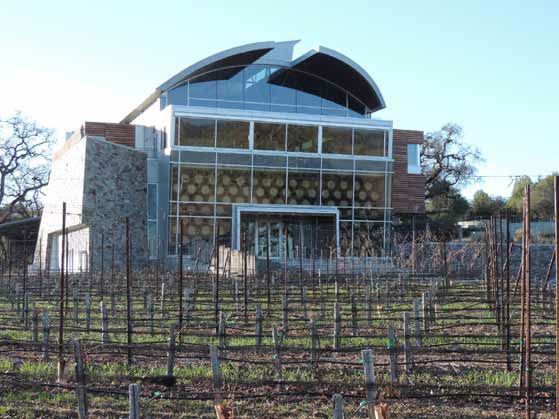 This article is the second in a series of in-depth profiles of distinguished Pinot Noir vineyards in California and Oregon. The vineyards are chosen by me for their record of producing consistently high quality Pinot Noir over multiple vintages. At this time, there is no classification of vineyards in North America and there is no established nomenclature to signify levels of quality such as is found in Burgundy. In 2001, John Dyson, the owner of Williams Selyem Winery, bought 51 acres on Westside Road in the Middle Reach of the Russian River Valley that had formerly been an apple orchard, hops farm and pasture owned by the descendants of Cecil and Luella Litton. The Cecil Litton Ranch property, located 7 miles southwest of Healdsburg and ! mile south of Allen Vineyard, and adjacent Arista Vineyards estate, was one of the last available premier vineyard sites on Westside Road. Dyson and winemaker Bob Cabral collaborated in planning the vineyard layout which surrounds the 30,000- square-foot winery. 32 sample pits were dug to study the various soil types and attempts were made to match the soils with compatible rootstocks. Because the soil was so rocky, many tons of rock were removed and re purposed in the property’s driveway leading to the winery and in the winery construction itself. The road connecting the winery to Westside Road was covered with nearly 70,000 tons of gravel crushed from the rock, and the interior walls of the east entrance were fashioned from excavated rock. Both natural habitats and over 100-year-old oak trees were preserved on the property.
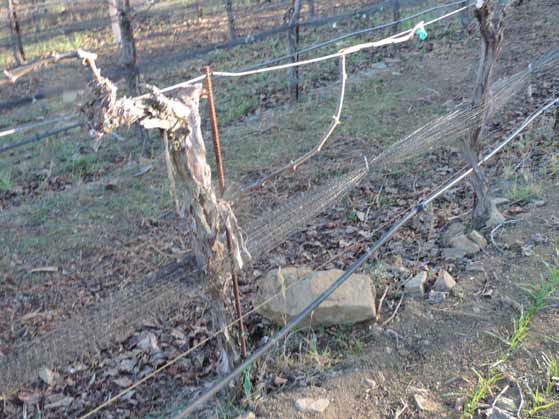 The initial planting of 19 acres started in 2002 in the upper hill portion of the land which presented a northeast to southwest aspect. The vineyard eventually grew in size to nearly 40 acres containing five different rootstocks and multiple clones, primarily heritage selections including Swan, Mt. Eden and Calera. Additional smaller plantings of Pinot Noir clones included Pommard and Dijon 777 and “828.” The vines were densely planted in 5’ x 7’ rows at 1,245 vines per acre and trained to a VSP trellis.
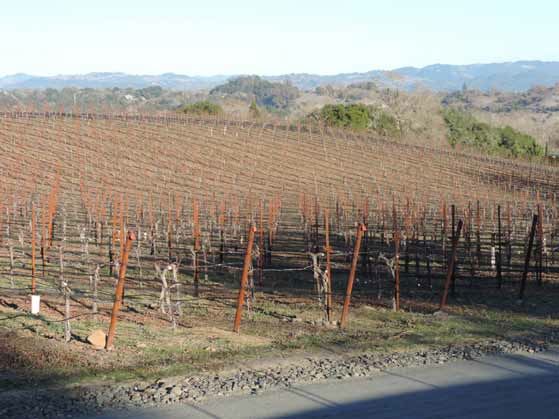 The Cecil Litton Ranch land also included a parcel on the eastern side of Westside Road, but has proven to be better suited for Chardonnay than Pinot Noir. The Estate Vineyard was initially named the Litton Estate Vineyard to honor Cecil and Luella Litton who had originally homesteaded the land in the 1850s. After the 2008 vintage, the vineyard name was changed to the Williams Selyem Estate Vineyard after an agreement with Ridge Vineyards, which produces the Lytton Springs, Lytton Station and Lytton Estate labels, named after Sonoma County pioneer William Litton. The Williams Selyem Estate Pinot Noir is a blend that includes at least 90% heritage selections, primarily Swan and Mt. Eden. Other selections and clones from the vineyard are vinified separately and added to the blend judiciously as needed, but most of that is included in the Russian River Valley and Westside Road Neighbors bottlings. There are plans to bottle the block of Calera selection separately in honor of Luella Litton. The Williams Selyem Estate Pinot Noir is vinified in the same fashion as the other Williams Selyem wines. After a cold soak, the grapes are inoculated with the Williams Selyem yeast isolate, 15-25% whole cluster fermented, and malolactic fermentation induced with one strain (ML-34). Fermentation is carried out in stainless steel dairy tanks. The use of cultured yeast adds consistency to the Williams Selyem house style. The wine is aged in 100% Francois Frères French oak barrels. The first vintage of Williams Selyem Estate Pinot Noir in 2005, commemorating the 25th Anniversary of Williams Selyem, produced only two barrels. The winery did not plan to bottle it for commercial sale since there was such a small quantity. However, the wine stood out after repeated tastings and it was decided to bottle it and give it away to the oldest and most loyal Williams Selyem customers. Mark Malpiede, the Vice President of Sales and Marketing, was very kind to offer me a tasting of the 2005 vintage, especially considering the winery only has about a case remaining. The Williams Selyem Estate Pinot Noir is priced at $100 and allocated to Williams Selyem mailing list members. Mark related a humorous story regarding the 2005 Williams Selyem Estate Pinot Noir. One of the customers who had received a bottle, called Mark in desperation trying to buy a bottle at any price. It seems his spouse had used the bottle for cooking and this had created significant marital discord. Mark patiently explained they had no wine to sell him. When Mark told the story to Williams Selyem winemaker Bob Cabral, Bob offered to give him a bottle from his own cellar (Cabral receives a case of every wine he crafts at Williams Selyem), and marital harmony was restored. To commemorate the 30th Anniversary of Williams Selyem with the 2010 vintage, an additional, very limited bottling of Estate Vineyard Pinot Noir was created. The first Williams Selyem Pinot Noir was produced from the 1981 vintage and carried the winery’s original Hacienda Del Rio label (photo below top). The best barrel of 2010 Williams Selyem Estate Pinot Noir was paired with the best barrel of 2010 Williams Selyem Burt Williams’ Morning Dew Ranch Pinot Noir and bottled as a collectable with the original Hacienda Del Rio label image and packaged in a special wooden box (photo below right bottom). Both 750 ml bottles ($250 for the pair) and magnums ($500 for the pair) were produced and sold only at the winery.
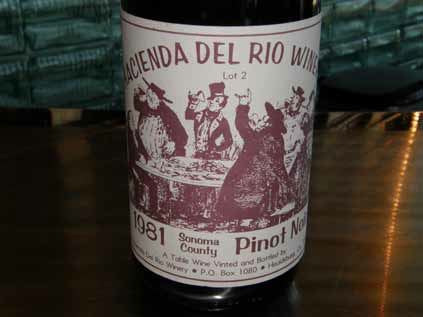
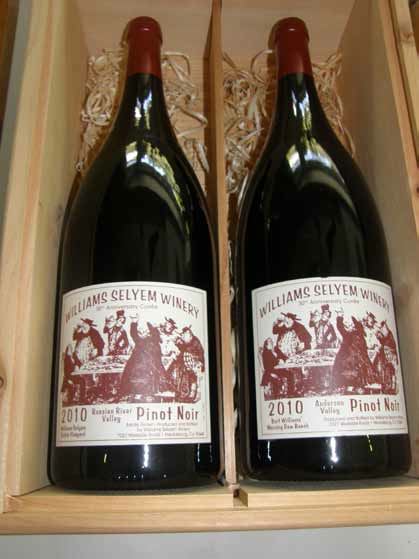 When Burt Williams (pictured below) came to the winery last year for pickup weekend, the winery gave him a 3 liter bottle of each wine. Those in attendance who bought the anniversary wines had Burt sign the bottles and boxes, creating quite a memorable occasion.
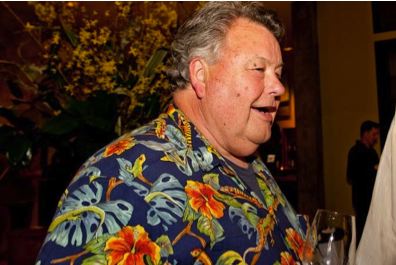 There is a unique 3-acre Block 10 planting within the Williams Selyem Estate Vineyard (pictured below). It consists of an 18 clone mass selection in which every eighteenth vine in each row is a different clone or field selection intermixed throughout the block, all on 420 rootstock. This type of planting was commonplace in
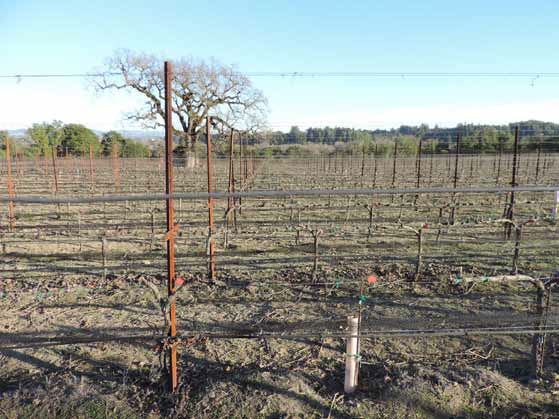 Europe before the discovery of the genetics of field selections. The clones or field selections are planted diagonally so they can be located. All vines are picked at the same time, even though ripening is variable and usually spread over two weeks in the vineyard. That way, some grapes are picked under ripe and some overripe, with most in the middle ground of ripening.
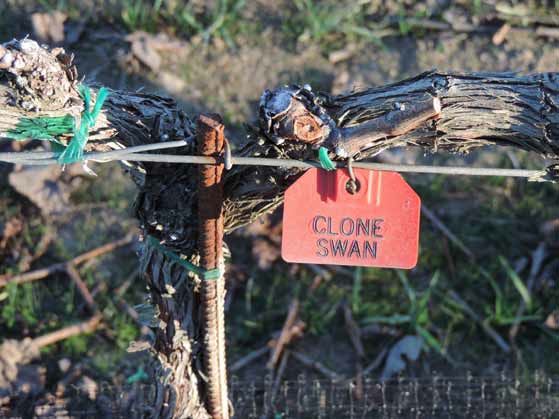 The first Block 10 Pinot Noir was produced in 2008. The winemaking for Block 10 is distinctly different from the other Williams Selyem wines. The cold soak is twice as long, 35%-38% whole cluster is used, fermentation is carried out by indigenous yeasts, and the wines are aged in two types of oak barrels: 50% in Francois Frères and 50% in Marcel Cadet. About 40% to 50% new oak is used and the wine is aged an additional 4 to 5 months (a total of 20 to 22 months) The goal is to make the Block 10 Pinot Noir stand out but not significantly alter the Williams Selyem style. The Williams Selyem Estate Vineyard Block 10 Mass Selection Pinot Noir is sold only at the winery for $75 and limited in allocation. The winery hopes to make the wine available for visitors to the winery to taste and purchase year round. The Williams Selyem Winery is open by appointment to WS List members for a tour and tasting for up to six people. Contact the winery two weeks before your planned visit at 707-433-6425. Visit the winery’s website at www.williamsselyem.com to join the WS List and have an opportunity to visit. When I visited Williams Selyem winery in the fall, Mark offered me a taste of the 2007 Williams Selyem Coastlands Vineyard Pinot Noir out of magnum. Coastlands Vineyard is a very cold site resulting in thick grape skins and dark color. I was quite taken by the wine which offered bright aromas of cherry and black raspberry, and flavors of earthy black cherry and peppery spice backed by suave, dry tannins. A real treat. I also tasted the 2012 Russian River Valley Chardonnay which is sourced from several vineyards and released in the spring at $39. It is an unoaked Chardonnay that is crisp and vibrant, tasting of fresh Gravenstein apples. I recently tasted a vertical of Williams Selyem Estate Pinot Noir, 2006 to 2011. The 2005 was tasted at the winery as I noted previously. The 2012 vintage will be released in the fall of 2014. I have not tasted the 2010 30th Anniversary bottling of the Williams Selyem Estate Pinot Noir. The 2011 Williams Selyem Block 10 Mass Selection Pinot Noir was also tasted and proved to be the star among all the wines. I believe the 2006, 2007 and 2008 wines have peaked or nearly peaked but should hold a few more years, while the later vintages are still young and have many good years ahead. The wines all display the luscious, ripe, sappy fruit typical of the Russian River Valley.
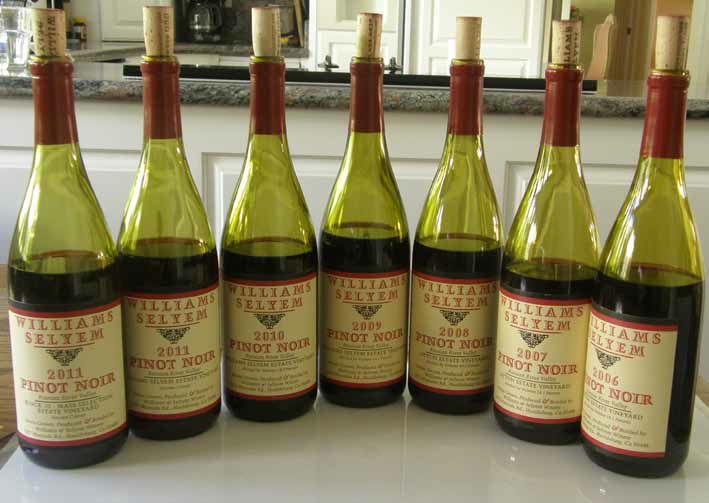
2005 Williams Selyem Litton Estate Vineyard Russian River Valley Pinot Noir 14.3% alc., 50 cases. · Moderate reddish-purple color in the glass. Flamboyant spice and Bing cherry on the nose. Mid weight core of dark cherry, baking spice and dried herb flavors with an impressively long fruit-driven finish. Still alive and vibrant. Drink. Score: 88
2006 Williams Selyem Litton Estate Vineyard Russian River Valley Pinot Noir 14.1% alc., $100. · Medium reddish-purple hue in the glass. An aged bouquet consisting of scents of fruit bin, dried cherry, leather and earth with a slight green herb note appearing over time. A bit rustic and a tad shallow in the mid palate, offering flavors of earth-dusted black cherries and a subtle flowery and vegetal note in the background. Some dry, suede tannins persist on the pleasingly ripe finish. Drink. Score: 86
2007 Williams Selyem Litton Estate Vineyard Russian River Valley Pinot Noir 14.1% alc., $100. · Moderately dark reddish-purple color in the glass. Nicely perfumed with aromas of Bing cherries, dark berries, spice, and oak vanillin. The very ripe, sappy fruit is noticeably intense on the mid palate and finish, and nicely framed by notes of spice, sarsaparilla and oak. Very smooth on the palate with integrated, balanced tannins. The finish really stands out in this wine. Drink or hold short term. Score: 91
2008 Williams Selyem Litton Estate Vineyard Russian River Valley Pinot Noir 14.2% alc., $100. · Dark reddish-purple color in the glass. Effusive aromas of black cherry, dark red rose petals and vanilla. Delicious and generous on the palate with a full-bodied core of dark cherry, berry and plum fruit. A bold and boisterous wine, yet it is balanced with some finishing persistence. The biggest wine of the vintages tasted here. Drink or hold short term. Score: 90
2009 Williams Selyem Williams Selyem Estate Vineyard Russian River Valley Pinot Noir 14.1% alc., pH 3.39, TA 0.66, $100. Barrel aged 17 months in 69% new and 31% 1-year-old Francois Frères oak. · Dark reddish-purple color in the glass. Lovely aromas of black raspberry, black cherry, baking spice and vanilla wafer. Full-bodied, with a sweet, sappy core tasting of very ripe dark stone fruits and boysenberries, complimented by spice and oak in the background, and framed by substantial supporting tannins. The mouthfilling fruit is fresh and charming, leading to a finish of exceptional intensity and length. Could benefit from more bottle age to further integrate the tannins and oak but hard to resist now. Hold or drink. Score: 91
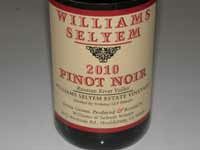 2010 Williams Selyem Williams Selyem Estate Vineyard Russian River Valley Pinot Noir 13.8% alc., pH 3.49, TA 0.64, $100. Barrel aged 11 months in 35% new, 35% 1-year-old, and 30% 2-year-old Francois Frères oak. · Moderately dark reddish-purple color in the glass. The nose draws you in with vibrant aromas of cherry pie glaze, cola, rose petal, spice and a hint of oak. The vivid, flamboyant dark cherry and black raspberry core is delicious. Noticeably seamless, with juicy acidity in this vintage, and modest, balanced tannins. The oak is flattering and the finish has striking length. Even better the following day from a previously opened and re-corked bottle. A sublime wine that will benefit from decanting if opened now. Drink or hold long term. Score: 94
2011 Williams Selyem Williams Selyem Estate Vineyard Russian River Valley Pinot Noir 13.9% alc., pH 3.46, TA 0.59, $100. Barrel aged 20 months in 79% new and 21% 1-year-old Francois Frères oak. · Moderately dark reddish-purple color in the glass. The initially bright aromas of Bing cherry, sandalwood and baking spice are subdued by oak over time in the glass. Mid to full-bodied flavors of ripe dark cherry, cranberry and cola with a noticeable imprint of dusty oak. The bright acidity lends grip and the tannins are tame. Much better the following day from a previously opened and re-corked bottle, showing better oak integration and more charm Hold long term. Score: 91
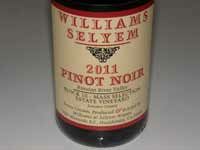 2011 Williams Selyem Block 10 - Mass Selection Estate Vineyard Russian River Valley Pinot Noir 13.7% alc., $75. · Moderately dark reddish-purple color in the glass. The nose unfolds beautifully over time in the glass, offering lovely aromas of fresh blackberry jam, earthy flora, and oak. A gorgeous wine with layers of flavor and nuance fanning out over the palate. Earthy black plum, red and black cherry and dark raspberry flavors are enlivened by bright acidity which lifts the orgasmic finish. Even better the next day from a previously opened and recorked bottle with an even more generous display of Pinot goodness. Extraordinary. Hold short or long term. Score: 95
Winemaker Bob Cabral succeeded Burt Williams at Williams Selyem in 1998 after the winery had been sold to John Dyson. He was able to carve out his own success, a difficult task when following the legendary accomplishments of Burt Williams. He oversaw and helped plan new vineyard plantings, directed the acquisition of new vineyard sources, and assisted in the construction of a new winery. In 2011, Bob was honored with the Wine Star Award for Winemaker of the Year. 2014 will be Bob!s 17th and last vintage at Williams Selyem. He cited “growing demands on him and his family” as a major factor in his decision. He has not said what his future plans will be, but he will continue to make wine as part of his own project and will be freed up to see more of his family, travel less and enjoy a more tranquil lifestyle. Another winemaker at Williams Selyem for the past three years, Jeff Mangahas, and his team, will continue the Williams Selyem style and tradition. Jeff, like Bob, was the winemaker at Hartford Court in the Russian River Valley before coming to Williams Selyem. He will be backed by assistant winemaker Patrick Bernard and enologist Jessica Gilmore.
Tasting Aged Williams Selyem Pinot Noir: Bottled SurprisesWilliams Selyem Pinot Noirs crafted by Burt Williams and Ed Selyem were amazingly fruity and complex when young and seemed to age better than most California Pinot Noirs of the 1980s and 1990s. Burt often claimed the wines peaked around 6 to 7 years after release, but most people found it very difficult to avoid drinking them before that time. At the 2010 World of Pinot Noir, there was a retrospective tasting of ten vintages of Williams Selyem Pinot Noir beginning with the “Burt” years (wines crafted by Burt Williams) including 1991, 1992, 1995, 1996 and 1997, and the “Bob” years (vinified by winemaker Bob Cabral who succeeded Burt at Williams Selyem in July 1998) including 1999, 2001, 2002, 2004 and 2005. The wines were all from the library of Williams Selyem Winery guaranteeing their provenance. My notes from the tasting revealed that the wines made by Burt Williams were still stunning examples of California Pinot Noir with all his wines exhibiting graceful aging except the 1991 vintage which was on the down slope. The 1985 Williams Selyem Rochioli Vineyard Russian River Valley Pinot Noir is often considered the most seminal wine in the history of California Pinot Noir. This wine won the Sweepstakes at the California State Fair Wine Competition. It was voted the best of the 2,136 wines entered by 416 wineries in 1987. 295 cases of this wine were produced and sold for $16 a bottle. Noted sommelier, Rajat Parr, posted on Instagram on December 18, 2013, that he had tasted the 1985 wine from what looks to be a 750 ml bottle in the posted photograph and commented, “Cheers to all those doubted that CA Pinot don’t age!”
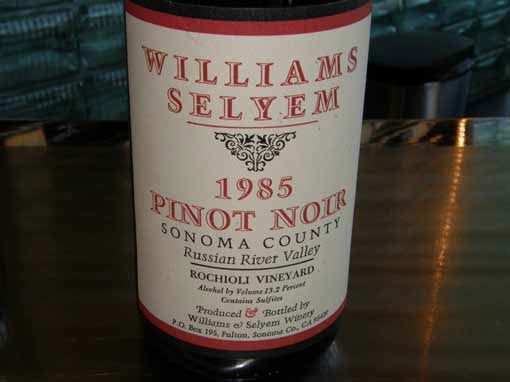 The award Williams Selyem received for the Sweepstakes at the California State Fair Wine Competition is currently displayed at the Williams Selyem winery hospitality center. It was found hanging on the wall at the old winery at Allen Vineyard and restored. When Burt saw it last year at the winery’s pick-up weekend, he was surprised to see it, and commented in his usual unassuming manner, “Oh, that’s nice.”
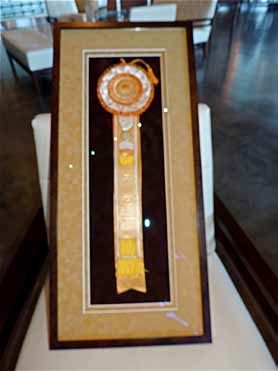 What were Burt’s secrets? First, he carefully chose his grape sources. Second, he was a meticulous winemaker. His technique involved intense sorting, de-stemming grape clusters and adding back 20% to 30% whole clusters to the bottom of his dairy tank fermenters, a 5-day cold soak, inoculating with a yeast he acquired from Martinelli’s Jackass Vineyard, initiation of hand punch downs with the onset of fermentation, and no pumping using gravity only or assisted gravity with gas. Free-run juice was sent to barrel, the residual must and juice was bucketed into the press, gently pressed, and added to the top of the barrel. Varying percentages of new Francois Frères oak were used depending on the vintage and the wine. Periodically, I get the urge to sample older vintages of Williams Selyem Pinot Noir. This is partly out of nostalgia and partly out of curiosity. Storage is everything when it comes to old wine and one must be very cautious buying older vintages of Williams Selyem wine on the secondary market if provenance is not well known. In the last couple of years I have had extraordinary drinking experiences with Williams Selyem Pinot Noir that Burt shared directly from his cellar. The safest bet is magnum format, but these bottlings have become scarce of late. My tasting reported here and other tastings over the past couple years, would lead me to encourage you to go for it if you find a Williams Selyem Pinot Noir from the early to mid 1990s that has been aged comfortably in a private cellar. 1995 is probably your best bet. As you can tell from my comments here, not all wines will be great, but most are of interest, and some are very giving. The best attitude to take when drinking these old Pinot Noirs is to appreciate them for what they give and not for what they lack. Most of these reviewed wines came from a private cellar. All appeared to be unfiltered. The wines have become more savory and less fruity over time, closer to the Burgundian paradigm. They are certainly in various stages of decline, but not decrepit by any means. A 1995 Hirsch Vineyard bottling was sadly corked. In my humble opinion, Burt Williams is the greatest Pinot Noir winemaker of my generation. Why he is not a consultant for one of the many Pinot Noir producers in California is a real head scratcher.
1993 Williams Selyem Sonoma Coast Pinot Noir 13.3% alc.. I have had this wine on two other occasions in the past few years in both 750 and magnum format and was pleasantly surprised. · Medium reddish-purple color in the glass with slight yellowing of the rim. The wine exhibits an old Pinot patina with a bouquet of dark red fruits, dried herbs and leaf. Very silky on the palate with supple tannins, picking up some fruit intensity over time in the glass. Seems like a wine made from slightly under ripe fruit yet soldiers on. Still quite nice the following day from a previously opened and re-corked bottle.
1994 Williams Selyem Rochioli Vineyard Russian River Valley Pinot Noir 13.4% alc.. · Moderately dark reddish-purple color in the glass with no bricking. Aromas of ripe black cherry, raisin, wood pile, old leather and barnyard. Plenty of secondary character highlights the charming spiced black cherry core which fills the mouth with pleasure and shows lasting power on the finish. The tannins are marshmallow soft, and the acidity holds the fruit to attention. This wine will thoroughly please lovers of older Pinot Noir.
1994 Williams Selyem Olivet Lane Vineyard Russian River Valley Pinot Noir 13.0% alc.. · Moderately dark reddish-purple color with slight yellowing of the rim in the glass. The nose offers an array of secondary characters including old book, vitamin, and potpourri to accompany the modestly aromatic cherry and red berry fruits. The wine is clearly fading, but is still likable with a flavorful core of red cherry fruit backed by juicy acidity and mild fine-grain tannins. Very smooth in the mouth, with a satisfying finish, holding up well in the glass over time.
1995 Williams Selyem Olivet Lane Vineyard Russian River Valley Pinot Noir 14.0% alc.. · Moderately dark mahogany red color in the glass with mild sediment. The aromas of cherries and spice soar from the glass upon opening but fade over time. Middleweight flavors of fresh black cherries and raspberries with a hint of seasoned oak. The fruit is fading, but the wine still has some satisfying fruit on the refreshing finish driven by juicy acidity. Most enjoyable within 30 minutes after pulling the cork. A great aged wine.
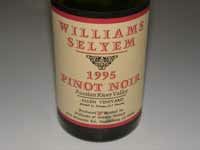 1995 Williams Selyem Allen Vineyard Russian River Valley Pinot Noir 13.7% alc.. · Beautiful deep mahogany color in the glass. Very sexy nose with fresh aromas of black cherry, spice, potpourri and peat. Still fresh and vivid with plenty of full-flavored, very ripe dark berry and dark cherry fruits with an appealing earthy bent. This was a remarkable bottle that belied its age and was simply extraordinary. When tasted the next day from a previously opened bottle, not surprisingly it had faded.
1996 Williams Selyem Precious Mountain Vineyard Sonoma Coast Pinot Noir 13.3% alc.. · Moderately deep reddish-purple hue in the glass. Bouquet of underbrush, earthy flora, mushrooms on the grill and old book. Earthy and rustic, but retaining some charming black cherry, raspberry and cranberry fruit. The wine still has some pleasing fruit intensity, complimented by a hint of spice with no intrusion of oak. Seamless and pleasurable for a 17 year old wine.
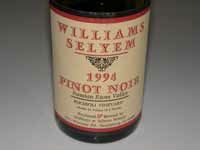 1996 Williams Selyem Rochioli Vineyard Russian River Valley Pinot Noir 13.7% alc.. · Moderately dark violet color in the glass. Vivid Moroccan spice and black cherry leap out upon opening but fading over time, taking on pleasant aromas of dark cherry, leather and incense. Middleweight essence of juicy black cherries and black plums with hints of spice, Hoison sauce, and tobacco. Very silky with gossamer tannins and still offering some fruit pizzazz but with a heavy oak sheen. An enjoyable but not exceptional old wine.
Pinot Noir “Clone 95”: Dick Erath Revives an Old TreasureDick Erath, one of Oregon’s original pioneering vintners, recently sent me a bottle of 2012 Clone 95 Pinot Noir from his Prince Hill Vineyard planting in the Dundee Hills of the Willamette Valley. Dick moved to Oregon in 1968 from Northern California where he grew up and earned an engineering degree. He had attended courses at University of California at Davis, and one of his classmates was Richard Sommer who would be the first to plant Pinot Noir in Oregon. Dick bought his first vineyard site in the Chehalem Mountains in 1968, and the following year planted four acres of Pinot Noir, Riesling and Gewürztraminer from cuttings he had brought with him from California. The vines did not survive a severe frost and late snow in 1969. He subsequently developed a business relationship with Cal Knudsen who owned vineyards in the Dundee Hills and later became a partner in the Argyle Winery. Dick produced his first 216 cases of wine, including 100 cases of Pinot Noir with the Erath label in 1972. In 1975, after Erath planted additional vineyards for Knudsen, the winery became known as Knudsen-Erath. In 1976, Dick started construction of the first winery in the Dundee Hills. About twelve years later, Dick bought out Cal’s interests and the winery became known simply as Erath again in 1983. Erath Winery became quite successful, growing to 35,000 cases by 1987. Erath Winery was bought by Ste. Michelle Wine Estates in 2006 with the new owners increasing production significantly. Dick kept his vineyards including Prince Hill Vineyards. Along with David Lett and Charles Coury, Dick led the lobbying effort in Oregon in the 1970s to limit the importation of grapevines into Oregon that were not virus-free, in the hopes that the use of only certified vines would prevent the spread of phylloxera and other vine diseases. In 1975-1976, Dick had a friend visit Clos Vougeot in Burgundy, and while there, he grabbed cuttings that lay on the ground, smuggled them into the United States, and gave them to Dick. Dick sent them to Austin Goheen at University of California at Davis Foundation Plant Services (FPS) to have the vines cleaned up. The original material was given the designation FPS S1 and initially underwent heat treatment. Goheen retired, and Dick heard nothing more for many years. Dick was to find out later that the original material had tested positive for virus in 1986 and underwent microshoot tip tissue culture disease elimination therapy, whereby a new selection plus some backup vines from the same material were created. Dick received a surprising letter from FPS in 1998 telling him the vines, which had been designated Pinot Noir FPS 95, “Were ready.” They sent him 5 disease-free vines. He now has 2 acres planted at his Prince Hill Vineyard in the Dundee Hills. FPS 95 was taken off the Davis listing because it tested positive for leafroll virus in 2005, although Dick has not seen that infestation in his vineyard plantings. The backup vines from the same source material were advanced to FPS 117, and are now available from FPS. Dick thinks FPS 117 (95) is similar to Pommard in appearance. However, it has higher tannin levels and is resistant to botrytis. In 2013 in the Willamette Valley, 8 inches of rain fell during harvest, but no botrytis developed in Dick’s FPS 117 plantings. Dick thinks that FPS 117 may be a good East Coast selection because of its resistance. Dick is currently working with Laurent Montalieu at NW Wine Co. to do a separate 2013 vintage bottling of “clone 95” under the Prince Hill label. Dick’s Prince Hill Vineyard, first planted in 1983, consists of 34 planted acres, 24 acres of which are Pinot Noir including clones 777, 667, 114, 113, 115, Pommard, Wädenswil, Coury, and 95. The vineyard has slow-moving phylloxera infestation. Dick currently sells budwood from his vineyard to raise money for his Erath Family Foundation that advances viticultural and enological science in Oregon. In 2012, Dick bottled one barrel of “Clone 95” Pinot Noir and one barrel of “Coury Clone” Pinot Noir from the Prince Hill Vineyard. He recently sent me a sample of each to taste. For a history of the “Coury clone,” refer to www.princeofpinot.com/article/1214/ (Solving the Mystery of the “Coury Clone”).
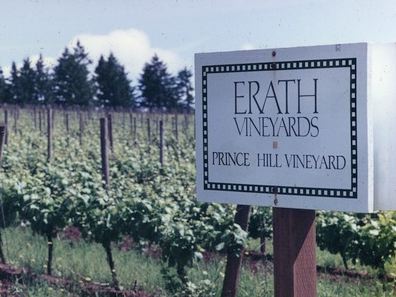
Failla WinesEhren Jordan’s biography is a fascinating study in life’s twists and turns. He grew up in a family of beer drinkers in Pittsburgh, Pennsylvania. While a college student studying art history and archeology at George Washington University, he worked part time in a retail wine store in Washington, D.C.. This experience led him to Aspen, Colorado after graduation, where he worked as a wine steward by night and played as a snow skier by day. During the Aspen off-season, driven by his retail and restaurant experience, and urged on by some of his Aspen restaurant co-workers who accompanied him, Ehren headed farther west to the Napa Valley where he worked his way up the wine business ladder with no formal winemaking experience. Blessed with a wry sense of humor, he proudly credits this with his success, but he is simply a smart guy. His first job in the Napa Valley was as a tour guide at Joseph Phelps where he met Bruce Neyers, the Vice President of Joseph Phelps. Neyers encouraged his advancement within the company, and Ehren soon became in charge of retail sales and eventually was hired to do cellar work and winemaking. Ehren then left for Europe for two years to intern with Jon Luc Columbo in France’s Cornas region of the Rhône Valley, learning about Syrah and Grenache. When he returned to the Napa Valley, he became a partner and winemaker at Neyers in 1994 (he still produces Failla wines at Neyers’ winery which he helped design and build in 2000), and then took the winemaking position at Turley Wine Cellars. Helen Turley introduced Ehren to her brother Larry Turley, the proprietor of Turley Wine Cellars, where Ehren first became Helen’s assistant and later the winemaker in 1996 upon her departure. He remained the winemaker at Turley Wine Cellars for 18 years, departing only last year. Turley, of course, was known for opulent Zinfandels resembling liquid Viagra, quite a dramatic departure from the graceful and elegant wines he produces today under the Failla label. That said, the Turley Zinfandels he crafted were still acid-driven wines. Ehren is not really as threatening as his website photo would suggest.
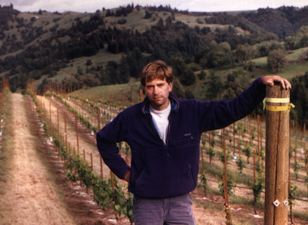 Failla (a Sicilian word pronounced “FAY-la”) was founded originally as Failla Jordan in 1998, using the name from the husband-and-wife team of winemaker Ehren Jordan and business manager Anne-Marie Failla. Ehren had spent several years looking for acid-driven, cool-climate Pinot Noir sources. After tasting Marcassin’s Pinot Noir from the Fort Ross-Seaview region of the Sonoma Coast, he bought 40 acres owned by pot farmers on what is known as the Gualala Ranch, and between 1998 and 2002 planted 10 acres of organically farmed Pinot Noir, Chardonnay and Syrah. Failla Jordan’s first releases were a Rhône-inspired Viognier and a Syrah. Pinot Noir debuted with a Keefer Ranch vineyard-designate in 1999 and an Oregon Pinot Noir from Willamette Valley’s Goldschmidt Vineyard followed in 2001. After three vintages, legal issues over the use of the word Jordan (as in Jordan Vineyards & Winery) forced them to shorten their winery name to “Failla.” Failla debuted in the fall of 2002 with a new label designed by Chuck House. The Failla Estate Vineyard wines debuted in 2006 and include a Rhône-style Syrah, Chablis-like Chardonnay and Burgundian-fashioned Pinot Noir. Additionally, Ehren has tinkered with many grape sources over the years, eagerly searching out marginal, old vine sources in cooler climates which he believes have the potential to be most site expressive. Although he admits that compelling wines are being crafted in California using young vine fruit, he is convinced that the next frontier will be the profoundness that comes with time as the vines age. The Failla Pinot Noir portfolio has included Keefer Ranch in the Russian River Valley, Hirsch Vineyard, Peay Vineyards, Pearlessence Vineyard, Occidental Ridge Vineyard and Whistler Vineyard, all located on the Sonoma Coast and in 2012, Savoy Vineyard in Anderson Valley. In 2012, Chardonnay sources include Hudson Vineyard in Napa Carneros, Chuy Vineyard in Sonoma Valley, Keefer Ranch in the Russian River Valley and Haynes Vineyard in Coombsville. A solid Sonoma Coast Chardonnay and Sonoma Coast Pinot Noir have also been consistently offered. Ehren is an admitted Francophile and his personal cellar is filled with French wines, especially Beaujolais which he enjoys drinking on a regular basis. That said, he is critical of the over use of new oak in many modern Burgundies, and prefers a very judicious use of oak, saying, “I am anti-oak. You can never take it away. It is analogous to a flavoring like salt. You want it in the food, but you don’t want the food to taste salty.” Look for Ehren at this year’s World of Pinot Noir and In Pursuit of Balance events. The Failla wines, which are released twice yearly in the spring and fall, are sold through a mailing list at www.faillawines.com. Tours and tastings are by appointment (707-963-0530). The 2012 Alban Vineyard Viognier, several 2012 Chardonnays, a 2012 Hudson Vineyard Syrah and several 2012 Pinot Noirs have just been released to mailing list customers. Listen to a conversation with Ehren at 2013 In Pursuit of Balance event in Los Angeles: http://www.graperadio.com/archives/2013/03/04/in-pursuit-of-balance-2013-los-angeles/.
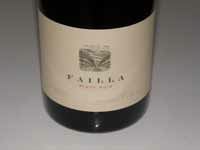 2012 Failla Keefer Ranch Russian River Valley Pinot Noir 13.9% alc., 900 cases, $48. 100% de-stemmed, aged sur lie in 33% new French oak barrels. · Moderately light reddish-purple hue in the glass. Vibrant aromas of fresh cherries, baking spices and sandalwood. Juicy and crisp, like biting into an iced cherry. Subtle touches of spice, earth and oak add interest. Very forward and easy to cozy up to with a long, aciddriven, mineral-laced finish. This wine really shows off the terroir of this Green Valley vineyard and could be a poster child for that cool-climate appellation. Will age beautifully. Score: 94
2012 Failla Whistler Vineyard Sonoma Coast Pinot Noir 14.1% alc. 260 cases, $52, This site lies in the northern most reaches of Sonoma County and all three acres are exclusively sold to Failla. Aged in 33% new French oak barrels. Some whole cluster inclusion during fermentation. · Medium reddish-purple color in the glass. Shy aromas of forest floor and black cherry pick up interest over time in the glass. Mid weight flavors of darker cherries and boysenberries with a subtle undertone of oak and stem. More body than the Keefer with less acidity. The tannins are well proportioned and the wine drinks seamlessly. Pleasant now, but not exciting and needs more time in the cellar. Tasted the following day from a previously opened and re-corked bottle, the stem note had disappeared and the wine offered an appealingly soft mouth feel. Score: 90
2012 Failla Pearlessence Vineyard Sonoma Coast Pinot Noir 13.6% alc., 325 cases, $45. A 2-acre vineyard located near the town of Sebastopol. Aged in about 25% new French oak barrels. · Moderate reddishpurple color in the glass. Fragrant with scents of dark cherries and berries, red plum, nutmeg and cozy oak. Delicious dark plum and purple berry fruits enhanced by a hint of spice and citrus, wrapped in balanced tannins, finishing with a very long, acid-driven finish. The darkest fruited of the three Pinots tasted here and showing the longest finish. Score: 91
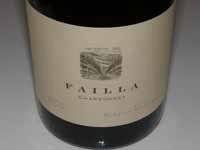 2011 Failla Keefer Ranch Russian River Valley Chardonnay 14.1% alc., 425 cases, $42. Very cool growing season. 25% of grapes were fermented in concrete egg vessels and 75% in 33% new French oak barrels. · Pale yellow color and clear in the glass. Appealing aromas of pear, applesauce, pastry cream, toffee and vanilla wafer. Slightly creamy and plush on the palate with vivid flavors of poached pear, baked apple, finishing with a caramel apple note and a charge of bright acidity. This wine has the apple by the tail. Score: 94
2011 Failla Chuy Vineyard Sonoma Valley Chardonnay 14.1% alc., 300 cases, $58. Dry-farmed, head-trained site tended by Chuy Ordaz since he planted the vineyard in 1964. Very tiny yields from Wente clone planting. · Moderate golden yellow color and clear in the glass. Fresh aromas of ocean air, apple pie and See’s toffee. Seamless on the palate, with assertive flavors of lemon and apple, and a silky mouth feel. Well-crafted with impeccable balance. The stony acid structure in this wine will lend itself to food. Score: 92
Sips of Recently Tasted Wines
Anaba (“anna-bah”) takes its name from the cool breezes called anabatic winds that frequently stream through the estate vineyard in Sonoma during the warm summer months. These unique air currents make the vineyard more temperate and slow down the ripening process. Proprietor John Sweazey sold his successful real estate finance company in 2003 and launched Anaba Wines after buying a vineyard property in western Sonoma Carneros. The Director of Winemaking and Vineyard Operations and General Manager is University of California at Davis-trained Jennifer Marion. The winery offers Rhône and Burgundian varietals grown on the estate vineyard, as well as wines from grapes sourced in other appellations. The tasting room is housed in a converted farmhouse that stood on Anaba’s J McK Estate Vineyard property. Visit www.anabawines.com. An interview with Jennifer Marion is on Grape Radio: www.graperadio.com/archives/2013/07/.
2011 Anaba Sonoma Coast Pinot Noir 13.9% alc., pH 3.48, TA 0.525, 518 cases, $34. Sourced from Sun Chase Vineyard located on Sonoma Mountain in the Petaluma Wind Gap region of the Sonoma Coast. Clones 667, 777, “828,” and 114. Harvest Brix 23.2-25.1º. De-stemmed, 12% whole cluster, 4 to 6-day cold soak, native fermentation, basket pressed, aged 11 months sur lie in 42% new French oak barrels. · Moderately light reddish-purple color in the glass. Pleasant aromas of fresh cherries and spice. Juicy and bracing, with demure flavors of cherry and cranberry with very subtle oak in the background. Fresh, forward and likable with gossamer tannins and bracing acidity. A solid wine. Score: 87
2011 Anaba Las Brisas Vineyard Carneros Pinot Noir 13.7% alc., pH 3.44, TA 0.54, 174 cases, $38. The Las Brisas Vineyard is part of the Mahoney Estate and sits on the Sonoma side of the Carneros appellation. It is named for the winds that drive morning fog away and bring in coolness in the late afternoon. Soils are predominantly clay. Swan and 667 clones. Harvest Brix 23.2º. 85% de-stemmed, 15% whole cluster, 5-day cold soak, native fermentation, basket pressed, aged 11 months sur lie in 33% new French oak barrels. · Moderately light reddish-purple color in the glass. Aromas of dark cherry, oak and bark lead to a smoky black cherry essence. On the light side and a bit flat, with silky tannins and a short finish. The oak tends to drown out the delicate fruit in this vintage. Score: 86
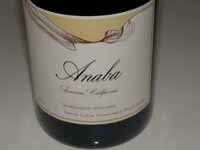 2011 Anaba Soberanes Vineyard Santa Lucia Highlands Pinot Noir 14.5% alc., pH 3.52, TA 0.65, 142 cases, $48. Pisoni clone. Harvest Brix 25.1º. Destemmed with 12% whole cluster, 4 to 6-day cold soak, native fermentation, basket pressed, aged 11 months sur lie in 37% new French oak barrels. · Moderately dark reddish-purple color in the glass. Very ripe fruited with hi-tone aromas of dark strawberries, muddled black cherries, raspberry jam and spice. Delicious flavors echo the nose with an appealing earthy underpinning. Impressive fruit presence with a balancing firm tannic backbone. The finish is striking and returns in waves for encores. Score: 92
2011 Anaba Sonoma Coast Chardonnay 14.0% alc., pH 3.45, TA 0.595, 432 cases, $28. Sourced from Sun Chase and Denmark vineyards, both located in the Sonoma Coast. Clones are Wente, RY17 and 95. Harvest Brix 22.8-24.0º. De-stemmed, 60% barrel fermented and 40% stainless steel fermented. · Moderate golden yellow color and clear in the glass. Very appealing nose offering fresh scents of citrus, spiced pear, buttery brioche and flint. Tasty core of baked pear, peach, spice and toffee flavors with a hint of salinity. Nicely balanced with bright acidity and a crisp, refreshing finish. Score: 90
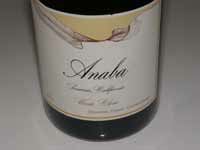 2011 Anaba Denmark Vineyard Wente Clone Sonoma Coast Chardonnay 14.1% alc., pH 3.54, TA 0.59, 240 cases, $35. 100% Wente clone. Harvest Brix 23.3º. Whole cluster pressed, cold settled for two days, 50% fermented in stainless vats, 40% in neutral French oak barrels. 40% of the wine went through MLF. Aged 11 months sur lie in 22% new French oak barrels. · Moderate golden yellow color and clear in the glass. The nose alerts you to a serious wine, with a perfume of ocean air, lemon curd and brioche. The lemon-based core is accented with tastes of apple and marzipan. A wine of breeding that is refined and sophisticated and possessive of a lip-smacking finish. Score: 92
2012 Belle Glos Dairyman Vineyard Russian River Valley Pinot Noir 14.8% alc., $44. This vineyard was planted to Dijon clones 115, 667 and 777 in 1989 on the site of an old dairy farm and purchased by winemaker Joseph Wagner in 2013. 100% de-stemmed, cold soak up to 2 weeks, proprietary yeast fermentation, punchdowns and punch-overs, free-run juice only, aged in 60% new French oak barrels for 9 months. The wine is typically racked twice during the aging process. The neck-dipped wax is appealing to look at, but the bottle is a bitch to open. · Deep, dark reddish-purple color in the glass. Aromas of oak vanillin, cake shop and marzipan with little fruit. Full-bodied, vanilla-infused flavors of dark berries, black plum and cassis with a heady oak sheen. Bold and opulent, with balanced tannins. The wine is fruit-driven and hedonistic with little Pinot character or site specificity. Score: 86
2011 Champ de Rêves Anderson Valley Pinot Noir 14.1% alc., pH 3.55, TA 0.57, $40. Sourced from the estate Boone Ridge Vineyard perched on the hills 1,500 to 1,800 feet above the town of Boonville, first planted in 2006. The 85-acre site is a patchwork of small blocks and seven clones. Clones 667, 777 and 115. !00% de-stemmed with 70% whole berries in tank. 5 to 7-day cold soak, open tank fermentation. Aged 9 months in 29% new French oak barrels. No racking out of barrel until blending before bottling. Winemaker is Eric Johannsen. · Medium reddish-purple hue in the glass. Blackberry and blueberry fruits are featured on the nose with hints of cut flowers and nutty, vanilla-infused oak. Medium to full-bodied flavors of ripe purple and black fruits with toasty oak in the background. The refined tannins are well-matched and there is noticeably bright acidity on the moderately long finish. Score: 88
13.5% alc., $63. This vineyard is located just outside the town of Graton and is planted in Goldridge soil on an east-facing slope. · Moderate reddish-purple color in the glass. Aromatically endowed with scents of dark red and black berries and oak. Soft, smooth and tasty on the palate, featuring blackberry, blueberry, savory dried herbs, and oak flavors caressed by supple tannins. Showing a touch more oak than I prefer but displays a lovely demeanor and is tre Pinot. Score: 89
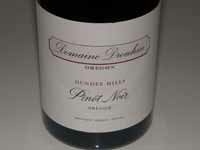 2012 Domaine Drouhin Oregon Dundee Hills Pinot Noir 14.1% alc., $35. · Medium reddish-purple color in the glass. Quite aromatic upon opening with scents of dark cherries, black raspberries, forest floor and a hint of rose petal. Mid weight flavors of darker cherries, raspberries and spice with a subtle oak sheen in the background. The core is fruity rather than complex. Somewhat reticent upon opening and a bit awkward. Big-boned and ripe for this bottling in this vintage and not showing the elegance and finesse that this bottling is known for. When tasted the following day from a previously opened and re-corked bottle, the wine was much more expressive and together, with bright flavors of dark red berries including strawberries, and cherries and spice. DDO wines have a history of admirable age ability and I would be in no hurry to drink this wine which needs at least another year in the cellar. Available from the winery in magnum and jeroboam formats. Score: 89
2012 Kirkland Signature (Costco) Russian River Valley Pinot Noir 14.2% alc., $12.99. Crafted by veteran winemaker Anthony Austin. Cellared and bottled by DC Flynt MW Selections in Healdsburg. · Moderate reddish purple color in the glass. Hi-tone aromas of Bing cherries, spice and raspberries with some new, sweet oak in the background infusing the nose with mocha. Tasty mid to full-bodied flavors of dark cherries and raspberries with a prominent oak sheen. Plush and velvety on the palate, finishing with more oak that I prefer. Very Russian River Valley in character and highly approachable now. Will have wide appeal especially at this price point. Score: 87
I have never had a bad bottle of Pinot Noir from La Crema and that pretty much sums it up. The prices have crept up from around $20 to $40 over the past few years, but the quality justifies the price increase. Under the Kendall-Jackson umbrella, La Crema has a large and diverse vineyard pallet to draw from in California.
2012 La Crema Panorama Vineyard Arroyo Seco Pinot Noir 14.5% alc., pH 3.68, TA 0.51, $40. Clones 667, 777, 23. A single estate vineyard bottling aged 9 months in 98% French oak, 28% new. · Aromas of dark berries, tea leaves, violets, and a hint of clove. Pleasing array of blackberry, ollaliberry and plum fruit with a note of oak that is beautifully integrated. A very harmonious wine that delivers pleasure now but has the balance to last another 6-7 years. Score: 91
2012 La Crema Russian River Valley Pinot Noir 14.5% alc., pH 3.61, TA 0.54, $40. Clones are Martini, 667, 115, Pommard and 2A. 100% de-stemmed, 70% whole berries, 5-day cold soak, aged 9 months in 30% new French oak barrels. · Moderately dark reddish-purple color in the glass. Shy blackberry fruit is accented by spice and smoky oak on the nose. Full-bodied, with deep flavors of black cherry, blackberry, black plum and cola. Atypical for the Russian River Valley in that it veers to the purple and black fruit spectrum. Well-managed firm tannins give the wine muscle and the finish is broad and generous. Seems a bit brooding at this stage and may blossom further with another year in bottle. Score: 88
A newer Santa Barbara County producer of limited production Pinot Blanc, Chardonnay and Pinot Noir under the direction of winemaker Kimberly Smith who was mentored by Wes Hagen of Clos Pepe. The first vintage of La Montagne (“The Mountain”) was 2010.
2011 La Montagne Sierra Madre Vineyard Clone 667 Santa Barbara County Pinot Noir 13.9% alc., 75 cases, $48. Clone 667 planted in sandy loam soils in 1971 by Robert Mondavi. Aged 18 months in 25% new and 75% neutral French oak barrels. · Medium reddish-purple color in the glass. Aromas of dark stone fruits and berries, spice and oak. The core of blackberry, black currant and black cherry fruit is juicy and flavorful, but a green, vegetal streak, which could be oak-induced, runs beneath the surface and spoils the experience. The tannins are well-mannered and their is some blackberry-driven finish with a flourish of oak. Tasted twice. Score: 86
2011 La Montagne Huber Vineyard Sta. Rita Hills Pinot Noir 50 cases, $55. From an older vineyard first planted in 1987. Clone 115. Aged 18 months in 50% new and 50% neutral French oak barrels. · Medium reddish-purple color in the glass. The nose is aloof initially, offering little fruit. On the palate, the wine tastes of tar and oily oak, with a modicum of dark berry flavor that is rather bland. The mouth feel is silky and the tannins are well managed. Tasted the next day from a previously opened and re-corked bottle, the fruit still had not shown up on the nose which exhibited aromas of dusty oak, stem and underbrush, and the flavor profile had not changed. Tasted twice. Score: 84
The following Cuvée Program wines are reasonably-priced, appellation-specific Pinot Noirs crafted by winemaker Aaron Walker and consulting winemaker Kenneth Juhasz at the Pali Wine Co. winery in Lompoc. These blends are crafted to show consistent style and flavor year after year.
2012 Pali “Huntington” Santa Barbara County Pinot Noir 14.2% alc., 9,218 cases, $22.50. Aged 10 months in 25% new French oak barrels. Sourced from 6 vineyards including Riverbench, Lucas & Lewellen, Bentrock, Radian, Presq’uile and Pence Ranch. · Moderately dark reddish-purple color in the glass. A very ripe, exuberant wine displaying aromas of blackberry jam, plum, balsam and oak spice and full-bodied flavors of black and purple fruits with a hint of raisin and oak. A pleasant, fruity wine with no special sense of place. Score: 86
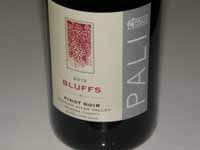 2012 Pali “Bluffs” Russian River Valley Pinot Noir 14.5% alc., 2,200 cases, $22.50. Sourced from Windsor Oaks and Rockin ‘B vineyards. Aged 10 months in 30% new French oak barrels. · Those nose offers aromas of black cherry, baking spices and vanilla. Medium to full-bodied black cherry flavor with a hint of spice. Very ripe fruit balanced by structured tannins, finishing with a sweet cherry flourish. Score: 88
2012 Pali “Summit” Sta. Rita Hills Pinot Noir 14.6% alc., 2,434 cases, $29. Aged 10 months in 30% new French oak barrels. Sourced from Bentrock, Radian, Fiddlestix, and Rancho La Vina vineyards. · Dark violet in color in the glass. Nicely perfumed with aromas of black raspberry infusion, blackberry tart and spice. Bold and assertive in a modern California style with decadent layers of sappy black raspberry and blackberry fruit. Velvety on the palate with balanced tannins and some finishing intensity. Score: 87
Patiné (pa-tee-nay) is a collaboration between Jim Fox, a former professional hockey player with the Los Angeles Kings, Dean Nucich, and winemaker Mike Smith. The name means “to have skated” in French. Smith mentored in the Napa Valley under noted winemaker Thomas Brown, and later founded his own label, Myriad Cellars. His current client list is impressive. A single Pinot Noir is offered from Gap’s Crown Vineyard in the Petaluma Gap region of the Sonoma Coast and sold through a mailing list at www.patinecellars.com. I believe this is the inaugural offering.
2011 Patiné Gap’s Crown Vineyard Sonoma Coast Pinot Noir 14.3% alc., $60. Clones 667 and “828.” · Moderately deep reddish-purple color in the glass. The wine continued to evolve in the glass over time to reveal enticing aromas of black cherry, black raspberry and black plum accented with spice. Full-bodied, yet harmonious in the mouth, with a luscious core of very ripe fruit, annotated by oak, finishing with generous aplomb. Tasted six hours later from a previously opened bottle, the wine was still drinking nicely with an appealingly smooth mouth feel. The fruit had become even darker, veering to black currant more than black cherry. This wine does push the ripeness envelope presumably because of a heat spike before harvest. A bit of alcoholic heat peaks out over time. That said, it is an enjoyable wine in the generous Caliesque style. Score: 89
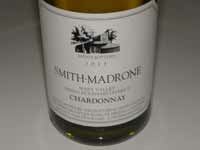 2011 Smith-Madrone Vineyards & Winery Spring Mountain District Napa Valley Chardonnay 14.2% alc., pH 3.30, TA 0.67, 463 cases, $30. Winemakers and winegrowers Charles and Stuart Smith. A very cool growing season. From a dry-farmed 13-acre vineyard planted in red and rocky volcanic soil. The vines are 39 years old. 100% barrel fermented in 100% new French oak barrels for 8 months. · Moderate golden yellow color and clear in the glass. This wine is about the soil and uniquely reflects the terroir. The nose is replete with aromas of iron, paraffin, peach and citrus. Crisp and bright on the palate, with layered flavors of lemon, green apple, spice, and iron. Beautifully balanced with a remarkably long finish for a Chardonnay. This wine can be cellared for several years, but drinks beautifully now. Score: 93
Vineyard-designated Pinot Noir crafted by winemaker Andrew Berge using fruit sourced from Sonoma County, Mendocino County and Yorkville Highlands. The winery has an impressive list of premium vineyards to draw from and Berge has shown to be a very talented winemaker. The wines are sold through a mailing list and on the website at www.spellestate.com.
2012 Spell Nichole’s Blend Sonoma County Pinot Noir 14.3% alc., pH 3.70, TA 0.59, 902 cases, $39. A blend of grapes from Lorenzo, Hurst, DeVoto, Marimar, Terre de Promissio and Alder Springs vineyards. Aged in 25% new, 25% once used, and 50% older French oak barrels. · Moderate reddish-purple color in the glass. Shy aromas of cherry cobbler, raspberry coulis and baking spices. Elegant in the mouth with tangy acidity, featuring black cherry and raspberry flavors. Pleasant, with modest tannins and easy approachability. Slow to open and may benefit from another 6 to 12 months in bottle. Score: 87
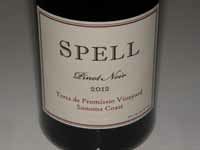 2012 Spell Terra de Promissio Sonoma Coast Pinot Noir 14.3% alc., pH 3.69, TA 0.60, 148 cases, $72. Clone 115. Aged in 40% new, 25% once used and 35% older French oak barrels. · Moderately dark reddish-purple hue in the glass. Very appealing nose with highly aromatic raspberry coulis scent. Beguiling middleweight flavors of fresh, dark cherries and raspberries, enveloped in submerged tannins, finishing long and generous with zippy acidity. Highly satisfying and easy to drink now. Score: 90
2012 Spell Marimar Estate Vineyard Sonoma Coast Pinot Noir 14.2% alc., pH 3.65, TA 0.61, 148 cases, $72. Sourced from the Dona Margarita Vineyard located in Freestone. Pommard 4 and Dijon 115 clones. Aged in 40% new, 25% once used and 35% older French oak barrels. · Moderately dark reddish-purple color in the glass. Fresh aromas of raspberry tart, cherry glaze and spice. A polished wine with broad flavors of black cherry and red raspberry with an earthy underpinning. The oak is nicely integrated and the tannins are modest and focused. About the same the following day from a previously opened and re-corked bottle. Seems to need more patience. Score: 90
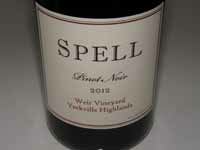 2012 Spell Weir Vineyard Yorkville Highlands Pinot Noir 14.3% alc., pH 3.68, TA 0.60, 194 cases, $50. Rochioli and “DRC” selection, Pommard and 2A clones. Aged in 40% new, 25% once used and 35% older French oak barrels. · Moderate reddish-purple color in the glass. The nose is initially closed for business, emerging very reluctantly over time in the glass to reveal aromas of Hoison sauce, soy and wet leaves. Mid weight core of luscious black raspberry and plum fruit, supported by balanced tannins, finishing with a thrust of fresh berry joy. When tasted the following day from a previously opened and recorked bottle, the wine had opened up considerably, offering copious fruit and spice aromas and flavors. This wine will require patience and understanding. Score: 91
2012 Spell Alder Springs Vineyard Mendocino Pinot Noir 14.2% alc., pH 3.75, TA 0.58, 149 cases, $50. Dijon 459, 115, 667 and 777, Calera and “DRC” selections. Aged in 40% new, 25% once used and 35% older French oak barrels. · Medium reddish-purple hue in the glass. Pleasant array of aromas including cherry, berry, forest floor and oak spice. Discreetly concentrated but intensely flavored darker red berries and black plums with an earthy bent. The wine offers a generous acid backbone and balanced firm, dry tannins with a smooth texture. Very typical of this vineyard in my experience. About the same the following day from a previously opened and re-corked bottle. Score: 89
Hearty Burgundy Celebrates 50 YearsI have fond memories of Gallo Family Vineyards Hearty Burgundy as it was my deceased father’s favorite wine. It graced our dinner table at home on multiple occasions, and was a frequent accompaniment to pizza when we dined at his best-liked neighborhood Italian restaurant. A proprietary blend of consistent style and quality with each vintage, the wine was first released in 1964 and this year is celebrating its 50th Anniversary. Hearty Burgundy was a favorite of Ernest and Julio Gallo and has a colorful history. According to Elen Hawkes who published Blood & Wine: The Unauthorized Story of The Gallo Wine Empire in 1993, some Gallo winery executives were allowed to order cases of wine at no charge for their personal use, and Ernest Gallo noticed that those employees with the best palates requested robust red wines like Baberone and Burgundy Pastosos. Ernest realized that Gallo needed a more full-bodied red than was available in the Gallo portfolio that included such red wines as Paisano and Chianti, and that is when Julio and his winemakers came up with Hearty Burgundy. The Hearty Burgundy blend was produced by adding more wine from Napa and Sonoma varietals to the winery’s Central Valley production. The base was Petite Sirah, Zinfandel (Julio’s favorite grape), and Carignan. However, early on, although technically the wine was not Burgundy, the wine did contain Pinot Noir. Joe Rochioli, Jr., told me that he initially sold his estate Pinot Noir to Gallo as there was little market for Pinot Noir in the early 1970s and his grapes went into Hearty Burgundy. John Bacigalupi recalls that the bulk red wines processed from his grapes at Seghesio’s facility in Healdsburg in the late 1960s and early 1970s, were shipped for market to Gallo and undoubtedly went into Hearty Burgundy. Today, we shutter to think that the prized Pinot Noir grapes from Bacigalupi and Rochioli met their fate in Gallo’s mass-produced Hearty Burgundy. Stephen Russell, former owner and winemaker at Prodigal Wines in the Sta. Rita Hills, went to work at Gallo after graduating with a degree in enology from University of California at Davis in 1960. He recalls, “The mixture of Zinfandel, Merlot and almost anything else available at the time was challenging to produce because the goal was to make Hearty Burgundy taste consistently the same although the types and sources of grapes varied widely with each vintage.” The exact blend of grapes in Hearty Burgundy has remained largely a trade secret and company policy prevents revealing the varieties of grapes used. Press releases in 2006 reported that the wine was a blend of Zinfandel, Tempranillo, Syrah, Petite Verdot, Grenache, and Cabernet Sauvignon. A current contribution from Pinot Noir is unclear, and unlikely, especially since Pinot Noir grapes are very expensive. Hearty Burgundy became wildly popular and widely praised by wine critics, even those who usually turned their nose up at the sight of the Gallo label. The wine graced the cover of Time magazine in 1972, an issue devoted to the booming California wine industry, and noted Los Angeles Times wine critic, Robert Balzer, wrote in that feature, “Gallo Hearty Burgundy is the best wine value in the country today.” Hearty Burgundy outscored more
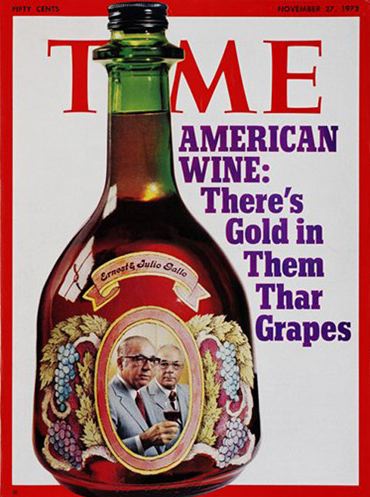 expensive California and French reds reviewed by the Time’s panel of tasting experts. Americans quickly embraced the wine as a result, and it was largely responsible for bringing Americans to wine. The wine was initial bottled in 1.5 liter “jugs.” According to Ellen Hawkes, Ernest Gallo wanted to change the Gallo reputation in the 1980s and in 1989 had even begun marketing a Hearty Burgundy Limited Release in 750 ml bottles in an attempt to remove it from the jug category. The wine was later retired for several years, but brought back in 2006 with a California appellation as part of Gallo’s new Twin Valley series of wines. On the occasion of the 50th Anniversary, Stephanie Gallo, a third generation family member and vice president of marketing said, “I have so many fond memories of sharing this wine with my friends and family, especially my grandfather Ernest - it was his favorite. Now in its 50th year of production, this wine represents the spirit of my family’s winery: quality wines at great value meant to be shared with all your families.” A commemorative, limited edition bottling of Gallo Family Vineyards Hearty Burgundy is now available for a suggested retail price of $9 for a 1.5 liter bottle (I found it for $6.49 at Total Wine & More). It features a special gold label as a nod to the wine’s “golden anniversary,” bears a 50th Anniversary seal, and the label proudly declares, “America’s First Iconic Red Blend.”
NV Gallo Family Vineyards Twin Valley California Hearty Burgundy 12.0% alc., $9 (1.5 liter). · Dark reddish-purple color in the glass. Highly aromatic with scents of blackberry jam on toast and oak-driven coffee and vanilla. Silky smooth on the palate with mid weight flavors of blackberry and black current annotated with vanilla and cedary oak. Very slightly sweet on the finish. Definitely hearty but not muscular or brawny. The wine’s wide appeal is understandable, especially at this value price. A solid pizza or BBQ wine. Score: 85
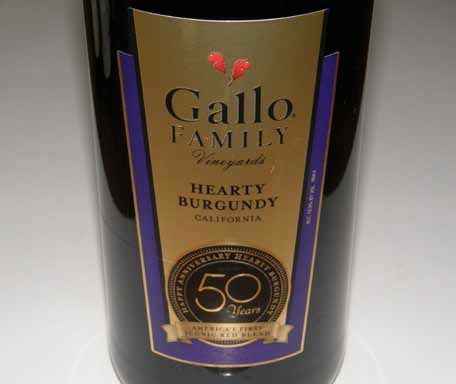
Tasting Rooms Threatening to Overtax Healdsburg and SonomaIt is understandable that residents and lovers of the quaint towns of Healdsburg and Sonoma want to preserve the cherished ambience and historic character that has defined these sleepy but charming farming villages. The problem is that these towns rely on the wine industry and tourism for their very existence, and they are logical locations for wine tasting rooms. The issue has been debated for some time in both towns. In 2011, the Healdsburg City Council left intact an informal guideline that allows one tasting room or bar per side of each downtown block and voted not to impose new restrictions on tasting rooms in that city. A recent article in The Press Democrat, “Sonoma identity crisis: too many tasting rooms?,” reported that Preserving Sonoma is urging the Sonoma City Council to put a cap of 30 tasting rooms in the city of Sonoma. The concern is that the city will become a monoculture of wine tasting locations and wine bars. A 2012 city survey found 24 wine tasting facilities in the Sonoma Plaza area (Healdsburg, in contrast, had 20 tasting rooms downtown then). Tasting rooms can open in Sonoma without a city use permit, and some have morphed into wine bars, serving wine from several producers. New standards approved by Sonoma’s Planning Commission on January 9, 2014, allowed tasting rooms smaller than 1,000-square feet to continue to operate without a use permit while wine bars and tap rooms would need a city approval. This contentious issue is to be discussed further by the Planning Commission and City Council in February. I recently counted 40 tasting rooms within downtown Healdsburg, three of which offer wines from multiple wineries making a total of 53 wineries. One could spend a week in Healdsburg and not visit even half of the tasting rooms, many of which are owned by wineries specializing in Pinot Noir. Here is a current listing:
Banshee Wines
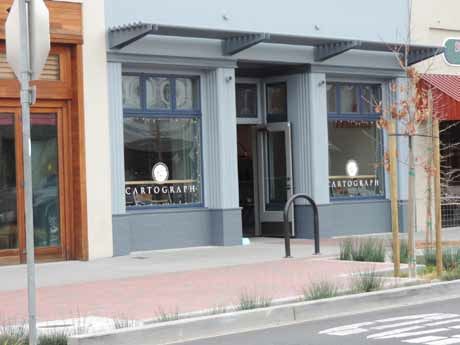
Chateau Felice
Front Street Wineries (Camellia Cellars, Holdredge Winery, J. Keverson, Kristie Vineyards, Pezzi King Vineyards, Sapphire Hill Winery, Skewis Wines, Teira)
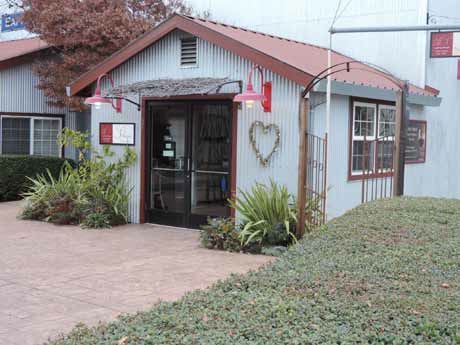
Hauck Cellars
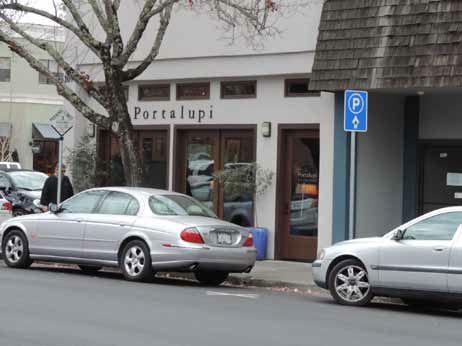
Ramey Wine Cellars
Downtown Sonoma currently has 20 tasting rooms. There is more variety here, with fewer wineries focused on Pinot Noir. Here is a listing:
Adobe Road Wines
My recommendation would be to seek out tasting rooms staffed by the winemaker or winery owner. Their presence often makes for a more informative tasting experience and can lead to a long term allegiance to the winery that is often enjoyable to the wine drinker.
Pinot Briefs12th Annual Pinot Noir Summi Want to be a Pinot Noir judge? Pit your palate against the pros by blind tasting and judging 40 top Pinot Noirs. Attend the Pinot Noir Summit in San Francisco on March 9, 2014. Check out the video to see what really happens: www.youtube.com/watch?v=EaaPVyzR73g. PinotFile readers can use the discount code, PSpinot, for a 20% discount on tickets available at www.pinotsummit.com.
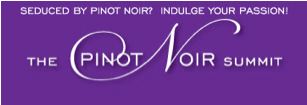 World of Pinot Noir A few tickets are still available for this year’s World of Pinot Noir, to be held at the Bacara Resort & Spa in Santa Barbara. Attend the Tasting by the Sea on Friday, January 28, or Saturday, March 1, where over 100 producers will be pouring Pinot Noir. At the Hollywood & The Vine Seminar on Saturday, March 1, Sara Schneider, the Wine Director for Sunset Magazine, will lead panelists on an exploration of why Pinot Noir has become such a Hollywood starlet. Taste Pinot Noir along with winemakers and Chris Burroughs who was in the ‘Sideways’ movie while the manager of the tasting room at Sanford Winery. Frank Ostini from Hitching Post II Restaurant will provide an oak-grilled lunch. For information and tickets, visit www.worldofpinotnoir.com.
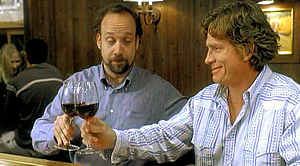 Carneros Wine Alliance Unveils “Voices of Carneros” Campaign The marketing program for Carneros has never been particularly noteworthy of late, but that is about to change. This month, the Carneros Wine Alliance (CWA), a non profit association of wineries and grape growers in the Carneros AVA, announced a new online media campaign called “The Voices of Carneros,” and unveiled a new website at www.carneros.com. The campaign is focusing on Carneros Chardonnay in 2014. Next year will be the 30th anniversary of CWA as one of the founding California AVA associations. Carneros is the only California AVA that spans two counties and is a complex appellation deeply rooted in agriculture and history. This cool climate region is influenced by the maritime weather of neighboring San Francisco and San Pablo bays, and has long been known for Pinot Noir, Chardonnay and sparkling wine production. It was the first California AVA to be defined by climate characteristics rather than political boundaries and achieved AVA status in 1983. The first local featured in The Voices of Carneros Campaign is Alison Crowe, winemaker for Garnet Vineyards. Santa Maria Valley Wine Country Association Disbands At the end of February, the Santa Maria Valley Wine Country Association, a group of vintners who promoted wineries and vineyards in the Santa Maria Valley for over ten years, will disband according to the Santa Maria Sun. The former members will bring their support to the Santa Barbara County Vintners Association and benefit from that organization’s promotional programs. The annual Chardonnay Symposium, held the past four years in Santa Maria, was sold to Dolphin Bay Resort & Spa in Pismo Beach. Record 2013 Harvest The North Bay Business Journal reported that the size and value of the winegrape crop in the North Coast reached new records in 2013, even surpassing the large 2012 crop. Overall, there was about a 1 percent increase in tonnage to 562,000 tons, equating to more than 400,000 more cases of wine according to preliminary figures from the California Grape Crush Report. The winegrape crop statewide increased 5.3 percent in 2013 to 4.23 million tons, topping the previous record set in 2012 of 4.02 million tons. That translates to more than 14 million more gallons of wine from the 2013 crush. Pinot Noir tonnage was increased by 0.8% in Mendocino, 2.5% in Sonoma, and 1.0% in the North Coast compared to 2012. 2013 was also a good year for San Luis Obispo and Santa Barbara County Pinot Noir where a record for tons crushed was set without sacrificing quality. Domestic Wines Off-Premise Sales Increased by 7% in 2013 According to Jim Gordon of Wines & Vines, off-premise sales finished 2013 at $7.3 billion for the year (IRi figures). Chardonnay and Cabernet Sauvignon were still the No. 1 and No. 2 top-selling varietals off-premises in 2013, but Pinot Grigio/ Gris took over the No. 3 position from Merlot. Pinot Noir enjoyed a 12% increase in off-premises sales and was by far the fastest growing high-priced varietal of 2013 with overall sales up 54%. Gallo, with an estimated volume of 80 million cases, remained the leading producer in California based on U.S. sales volume. United States Wine Consumption Continues to Rise According to the Wine Market Council’s Annual Report, Americans drank 297 million cases of table wine in 2013, an increase of 1.5 million cases over the previous year. 47 percent of buyers consumed budget wines priced less than $10 regularly, while wines priced more than $20 a bottle attracted 34 percent of buyers. Women drank more wine occasionally than men, but an equal number of men and women were frequent wine drinkers. The survey found that the biggest group of wine consumers by generation were Boomers (44 million), Generation X (44 million), and Millennial (70 million). Older Americans consume more wine at home while Millennials drink more wine at bars or restaurants and tend to drink more high-end wine. California ranked first in wine purchases. The popularity of red wines are growing faster than white wines. Sales of Malbec, and sweet and sparkling wines led by Moscato and Prosecco, are gaining significantly. Sales of 3-liter box wine are soaring. Meet the Masters at Bacara Resort Bacara Resort & Spa, on the bluff and beaches of the Gaviota coast, is opening its famed 12,000 bottle wine cellar to the public for a series of special wine and spirits dinners called “Meet the Masters.” These events will be offered the third Thursday of every month in Bacara’s Miró Restaurant. The four-course tasting menu will be designed by Miró Chef Johan Denizot and each course will be expertly paired with wine and spirit selections by a master wine or spirit sommelier. Cost by reservation is $150 per person. For additional information and tickets, visit www.BacaraResort.com.
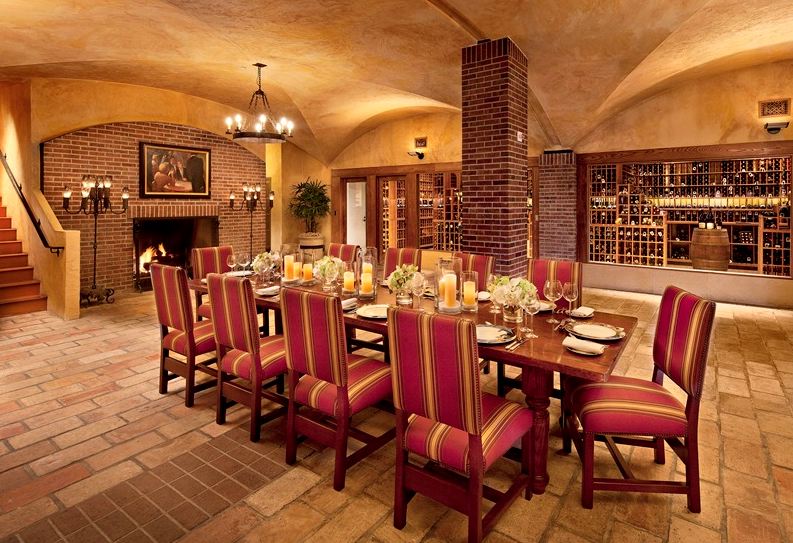 Ken Brown Opens New Tasting Room Ken and Deborah Brown are holding the grand opening of their new tasting room in Buellton on Sunday, February 23. The setting features the photography of renowned talent Randy Leffingwell. Regular tasting room hours are Thursday through Sunday from 11:00 AM to 4:30 PM and by appointment on Mondays. The address is 157 W. Highway 246. Ken will be pouring at this year’s World of Pinot Noir Grand Tasting by the Sea on Saturday, March 1, from 3:00 to 6:00. Talley Offers Wine on Tap Talley Vineyards now offers reusable glass “growlers” that you can fill up at the winery and take home to enjoy. Purchase a Talley growler (1.89 liters or a little over two regular bottles) at the tasting room and fill it up with your choice of wine, then return when you are ready for a refill. The available varietals and blends change seasonally, but special small batches of wine are created just for on-tap customers. Growlers require less packaging, so they are environmentally friendly and create cost savings that are passed along to wine drinkers. Visit www.talleyvineyards.com. 5th Annual Chardonnay Symposium This event has moved from Santa Maria to the Dolphin Bay Resort & Spa in Pismo Beach and will be held May 16-18, 2014. On May 16, there will be a wine country inspired dinner at the Lido Restaurant prepared by executive chefs Maegen Loring and Jacob Moss. The following day is the TCS Seminar, Panel Discussion and Grand Tasting & Silent Auction. The Seminar will be moderated by Steve Heimoff, the West Coast Editor of the Wine Enthusiast, and will include debates on the role of oak, malolactic fermentation, clones and manipulation of Chardonnay wine. The Silent Auction benefits the Cal Poly Wine & Viticulture Program. On May 18, many Central Coast wineries will offer promotions and events. For more information, visit www.thechardonnaysymposium.com.
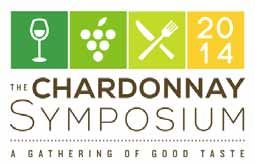 Santa Cruz Mountains Pinot Paradise 2014 The 3-day program presented by the Santa Cruz Mountains Winegrowers Association has been announced. The Wine Technical Session on Friday, April 11, will be titled “A Return to Paradise; Wine Making in a Mountain Terroir.” Speakers will be famed Sonoma Coast winegrower David Hirsch and Associate Research Soil Scientist at UCD, Dr. Jean Jacques Lambert. On Saturday, April 12, is the Pathway to Pinot Paradise where the many Pinot Noir producers of the Santa Cruz Mountains will hold open houses and conduct tours. On Sunday, April 13, the Pinot Noir Grand Tasting will feature 35 Santa Cruz Mountains producers pouring over 150 wines. For information and tickets, visit www.scmwa.com.
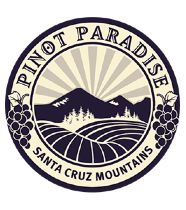 Hedges Taps Large Bottles Instead of Kegs Christophe Hedges of Hedges Family Estate on Red Mountain in Washington State has decided to be the largest 5 liter producer in the world. Large formats have been successful in the off-premise world, but to push the trend to on-premise restaurants and wine bars, Hedges is tapping 5 liters using taps from NitroTap.com. The idea has been introduced to the on-premise arena in a few states, including California, and it is taking off. Who doesn’t want to buy a glass of wine from a gorgeous 5 liter bottle standing proud on the bar? The Hedges Family Estate website is www.hedgesfamilyestate.com.
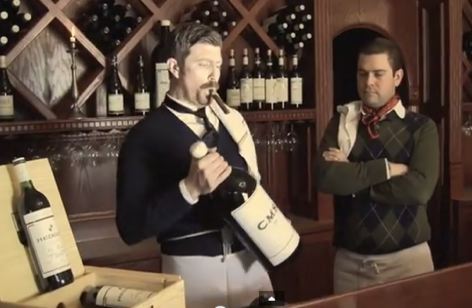 Pinot Classic in Russian River Valley The Russian River Valley Winegrowers (RRVW) are sponsoring the Pinot Classic, a multi day celebration of Russian River Valley Pinot Noir, on Memorial Day Weekend 2014. The three day event includes a Neighborhoods Seminar that explores the different neighborhoods or subregions of the Russian River Valley, Passport to Pinot involving barrel tasting, vertical and library wine tasting, and vineyard tours at more than 30 wineries throughout the Russian River Valley, and the Paulée Dinner with participating wineries that include Arista, Benovia, DeLoach, Hartford Family, Joseph Swan, Kosta Browne, Merry Edwards, and Williams Selyem. Tickets are no available at www.pinotclassic.com.
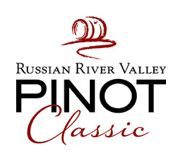
|